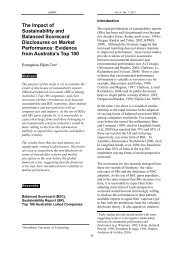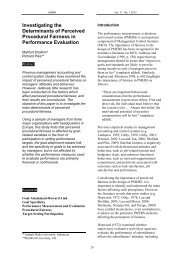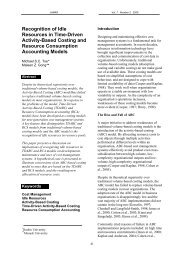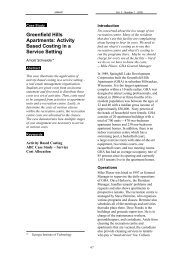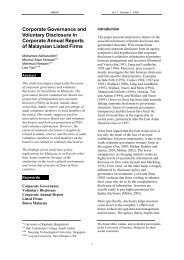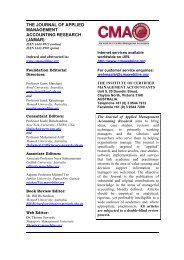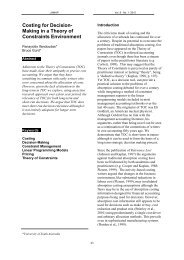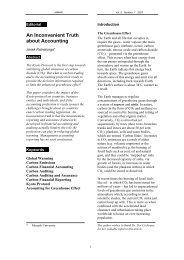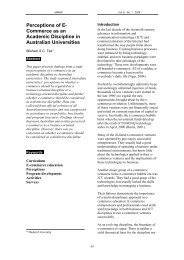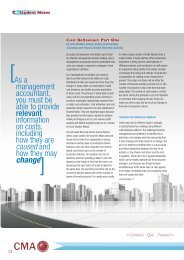Balanced Scorecard Design and Performance Impacts: Some ...
Balanced Scorecard Design and Performance Impacts: Some ...
Balanced Scorecard Design and Performance Impacts: Some ...
You also want an ePaper? Increase the reach of your titles
YUMPU automatically turns print PDFs into web optimized ePapers that Google loves.
JAMAR Vol. 6 · Number 2 · 2008likely to dem<strong>and</strong> greater communicationbetween organisational levels, transparencyof accountabilities, more focused attentionon long-term strategic goals <strong>and</strong> a betterunderst<strong>and</strong>ing of the leading, <strong>and</strong>actionable, drivers of performance.Although these reasons are speculative,these processes may account for thedifferences in BSC benefits <strong>and</strong>performance outcomes. A second keyimplication is that the BSC is not a “onesize fits all” system. It is clear that there issignificant variation in the way in which theBSC has been implemented inorganisations. In particular, it appears thatthe BSC may be used equally well as amanagement by objectives system, wheremanagers are held accountable foroutcomes <strong>and</strong> have compensation tied to<strong>Scorecard</strong> measures, or as a strategicinformation tool, where the emphasis isplaced on learning <strong>and</strong> problem solving.Reasons for adoption, <strong>and</strong> desired benefits,will dictate how the BSC is implemented<strong>and</strong> constructed. Following from this, firmsthat consider their current BSC ineffectiveshould review the design elements of theBSC to see whether these match the desiredpurpose, rather than discarding the systemaltogether.This study, like any empirical research, hasits limitations. First, as only a limitednumber of design <strong>and</strong> use characteristicswere considered, this leaves the potentialfor omitted correlated variables. This mightbe of some concern for the first propositionrelating to cause <strong>and</strong> effect logic. Given thecriticism of this concept, it may be theprocesses, communication patterns or someother mechanisms that are driving theresults, rather than just the existence ofcause <strong>and</strong> effect logic in BSC design.Second, it may be considered that the use ofsingle item constructs is too simplistic tocapture the variables of analysis. This is notnecessarily the case, as it has been shownempirically in other academic disciplinesthat single-item measures are appropriate incircumstances where items are wellunderstood by survey respondents (see forinstance Bergkvist <strong>and</strong> Rossiter, 2007),although a deeper analysis of the use of theBSC, as suggested above, would likelyrequire the use of multiple-item constructs.Finally, generalisation of the findings toother settings must be done with caution,particularly given the unique findingsconcerning adoption <strong>and</strong> extent ofimplementation in Australian firms thatsuggests the use of the BSC in this contextdiffers to that in other national settings.Despite these limitations, the study providesa number of interesting findings that haveboth academic <strong>and</strong> practical relevance, <strong>and</strong>provides a strong impetus for futureresearch on the design <strong>and</strong> use of the BSC.ReferencesAtkinson, A., Balakrishnan, A.R., Booth,P., Cote, J. M., Groot, T., Malmi, T.,Roberts, H., Uliana, E. <strong>and</strong> Wu, A. (1997),“New Directions in ManagementAccounting Research,” Journal ofManagement Accounting Research, 9, pp.79-108.Barker, R. T. <strong>and</strong> Camarata, M. R. (1998),“The Role of Communication in Creating<strong>and</strong> Maintaining a Learning Organisation:Preconditions, Indicators <strong>and</strong> Disciplines”,Journal of Business Communication, 35(4),pp. 443-467.Bergkvist, L. <strong>and</strong> Rossiter, J. R. (2007),“The Predictive Validity of Multiple-ItemVersus Single Item Measures of the SameConstruct”, Journal of Marketing Research,44(2), pp. 175-184.Bisbe, J., Batista-Foguet, J-M. <strong>and</strong>Chenhall, R. (2007), “DefiningManagement Accounting Constructs: aMethodological Note on the Risks ofConceptual Misspecification”, Accounting,Organizations <strong>and</strong> Society, 32(7-8), pp.601-637.Bonner, S. <strong>and</strong> Sprinkle, G. (2002), “TheEffects of Monetary Incentives on Effort<strong>and</strong> Task <strong>Performance</strong>: Theories, Evidence,<strong>and</strong> a Framework for Research”,Accounting, Organizations <strong>and</strong> Society,27(3), pp. 303 -345.Bryant, L., Jones, D. A. <strong>and</strong> Widener, S.(2004), “Managing Value Creation Withinthe Firm: an Examination of Multiple33



